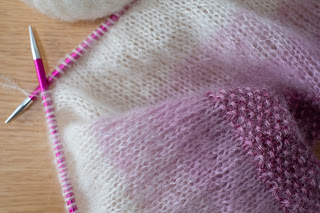If you're a fan of amigurumi and blooming
flowers, get ready to fall head over heels for our latest tutorial on crochet,
an adorable amigurumi heart flower pot. All you'll need is your favorite crochet hook - whether
it's your trusty Tunisian
crochet hook, a single-ended one, or perhaps something from your
cherished crochet hook set. Pair it with
some vibrant yarn in your favorite colors and a little bit of love, and you'll
be able to create a stunning piece that will brighten up any corner of your
home. So grab your hooks, and let's begin this step-by-step journey to crochet
blooming love!
Amigurumi Heart Flower Pot
Materials:
●
Any yarn in pot color, dark brown,
green, and heart color
●
Crochet hook (See the yarn label
to choose the preferred size)
●
Polyester fiberfill
●
Cardboard (such as from a tissue
box or cereal box)
●
18 gauge floral wire
●
Pliers
●
Fabric glue
●
Stitch
marker, yarn needle, scissors
Finished Size:
The finished heart in a pot measures
approximately 4 inches (10cm) tall, but it may vary as per the tension and used
materials.
Pattern Instructions:
Pot
Round
1: Make 6 single crochet using a magic ring.
Round
2: Increase in each stitch (12 stitches).
Round
3: Single crochet in next stitch, increase; repeat
around (18 stitches)
Round
4: Single crochet, increase, single crochet in next 2
stitches, increase; repeat around, single crochet in the last stitch (24
stitches)
Round
5: Single crochet in next 3 stitches, increase; repeat
around (30 stitches)
Round
6: Work in the back loops only, single crochet in each
stitch around (30 stitches)
Rounds
7-12: Single crochet in each stitch around (30
stitches for 6 rounds)
Round
13: Slip
stitch and chain 1; repeat around. Slip the
stitch into the same stitch as the starting slip stitch. Fasten off and weave
in ends.
Measure the pot's base and use cardboard to
make a circle.
Leaves (make 2)
Chain 7, slip stitch in second chain from hook
and next chain, single crochet in next 2 chains, half double crochet in last 2
chains (6 stitches).
Leave a long tail for stitching with a wool
needle and bind off.
Heart
Round
1: Make 6 single crochet using a magic ring.
Round
2: Now increase in each stitch. Total 12 stitches.
Round
3: Single crochet in each stitch. Bind off,
leaving a tail of approximately 10cm for sewing.
Continuation of Heart:
Repeat Rounds 1-3 without binding off.
Round
2: In the next round, join the two pieces to form the
heart's top.
Round
3: Make 6 single crochet on the second piece, then 12
single crochet on the first piece (starting in the first stitch of the last
round), make 6 single crochet on the second piece (24 stitches total).
Hem up the opening between the two parts using
the yarn tail that's left over from the first piece. Tie a knot to secure it.
Round
4: Single crochet in each stitch around (24 stitches).
Stuff the heart as you go.
Rounds
5-6: Single crochet in each stitch around (12 stitches
for 2 rounds).
Round
7: Decrease in each stitch around (6 stitches). Cut
the yarn, leaving a tail, and pull through the last stitch. Thread the yarn
tail through only the front loops of the last round without tightening. Set
aside.
Soil
Round
1: Form a magic ring and work 6 single crochet
stitches into it.
Round
2: Increase in each stitch around.
Round
3: Single crochet in next stitch, increase; repeat
around (18 stitches)
Round
4: Single crochet, increase, single crochet in next 2
stitches, increase; repeat around, single crochet in the last stitch (24
stitches)
Round
5: Single crochet in next 7 stitches, increase; repeat
3 times (27 stitches)
Rounds
6-9: Single crochet in each stitch around (27 stitches
for 4 rounds)
Round
10: Single crochet in next 7 stitches, decrease;
repeat 3 times (24 stitches)
Round
11: Single crochet in next stitch, decrease; repeat 8
times (16 stitches). Leave the yarn attached and set aside while you prepare
the stem.
Stem:
●
Use pliers to shape one end of the
wire into a 1/2 inch (1.5cm) wide circle. Insert it into the soil with the long
end coming out from the center.
●
Trim the wire to your desired
length plus 2cm (e.g., for a 4cm stem, make it 6cm long), and fold the end over
by 1cm.
●
Continue crocheting at Round 12 of
the soil, decreasing in each stitch around.
●
Cut the yarn, leaving a tail.
Bring up a long green yarn (about 40cm) through the soil's center.
●
Wrap the yarn around the wire
tightly, ensuring no wire shows. Add fabric glue to secure.
●
Place the heart over the wire and
wrap excess yarn around the bottom, securing it inside the heart.
●
Sew leaves to the soil on each
stem side and weave in all green yarn ends.
●
Close the bottom of the soil by
weaving the ending yarn tail through the front loops only of the final round,
pulling it closed and hiding the end inside.
●
Place the soil inside the pot.
Fantastic job on crafting the adorable pot!
Let's find the perfect spot to showcase it, where it can brighten up the room
and fill it with warmth and joy. Additionally, we've published a blog post
discussing selecting the ideal crochet hooks sets for amigurumi projects.
Take a moment to read it, and use the insights gained to make a well-informed
decision for your next creative endeavor.


.JPG)




.jpg)

